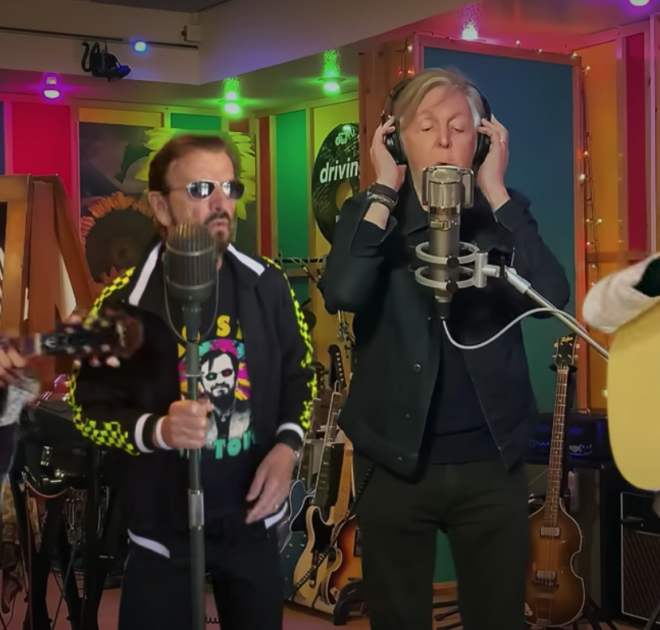The Beatles together once again: a fantasy made possible by AI

Article author :
The news had made the rounds of the social networks and the fantasy of many fans has become a reality: the legendary group The Beatles has reunited, 53 years after splitting up. A brand new track bringing the 4 members together has been created thanks to AI and broadcast on radio channels as well as on numerous streaming platforms. AI as a means of bringing the dead back to life: a technical feat or a worrying innovation?
November 2, 2023, will remain forever etched in the history of music. AI (artificial intelligence) has performed miracles: The Beatles have once again been brought together for a previously unheard song. Now and Then is the title of the group’s new and last single. A leap in time, which can be listened to on the clip below.
A recording from the 1970s brought back to life
An APF dispatch reveals that the track was born from a draft recorded by John Lennon in his New York apartment. After his murder in 1980, Yoko Ono – his widow – gave the tape (including the singer’s voice and piano playing) to the other members of the group. The only problem being that the technologies of the period did not allow John Lennon’s voice to be isolated and extracted with sufficient quality.
In 2023, AI carried out the unimaginable: isolating the voice of John Lennon to add to it the bass of Paul McCartney, the drumming of Ringo Star and the guitar of George Harrison. Over 50 years after the group split up and the death of several of its members, a new Beatles track has emerged thanks to AI. A technological feat which has delighted fans the world over: in scarcely three weeks of broadcasting, the track has already gained several million listens and views.

When AI brings the dead back to life: technological feat or worrying innovation?
For a few years now, AI has been enabling the dead to be brought back to life for the duration of a conversation, a song, an interview or a video.In the world of music, several examples have made a big impression. We are thinking in particular of the posthumous album The Lost Tapes of The 27 Club, created by an algorithm and making use of the voices of artists in the notorious 27 Club (Amy Winehouse, Kurt Cobain or Jimi Hendrix). Unlike the new song by The Beatles, the tracks on this album were entirely created from scratch by AI.
In 2018, it was the Spotify platform which caught the music industry by surprise in producing the album Hello World, composed by the Flow-Machines AI (our compatriot Stromae was for that matter one of the artists contributing to the collaboration). In April 2023, a Tik Tok creator hit the headlines in composing ‘Heart on My Sleeve’: a song combining the AI generated voices of Drake and The Weeknd. The track went viral, before being withdrawn from all the platforms owing to obvious issues concerning copyright. More recently, and in a completely different register, Warner Music announced a biopic project featuring Edith Piaf produced with the aid of AI.
All so many examples which demonstrate that AI is on a roll in the music sector, but not only… Amongst the techniques made possible is Deepfake (the act of superimposing existing video or audio files onto other files – by for example changing the face of a person on a video).
Thus, thanks to AI, it is possible to make a living person say whatever you want and/or literally make a deceased person speak again. This technique is used for entertainment purposes, much as the French TV programme Hôtel du Temps, which ‘interviews’ artists known to be deceased such as Dalida, or in the vein of the numerous videos on Tik Tok in which it is absolutely possible to see and hear Emmanuel Macron humming a song by Angèle, for example.
Whilst some see in this a technological feat allowing new life to be given to icons who have passed away, others fear and caution against abuses by raising several questions about Deepfake and the use of AI in the music sector.
How do things stand concerning the consent of the deceased person? And what about the proliferation of fake news via this special effects technology? What impact does AI have on copyright? What place for the artists in a market inundated by songs generated by AI?
The previously unheard track ‘Now and Then’ by The Beatles does not raise all of these ethical questions because the track was not created entirely by AI. Yet, this historical release retriggers the question of AI in artistic creation. As is true of any tech and digital innovation, the debate is a lively one, the division between constructive ‘for’ and ‘against’ arguments having equal merit, leaving it up to the public to come to a nuanced opinion on the issue.
A story, projects or an idea to share?
Suggest your content on kingkong.





